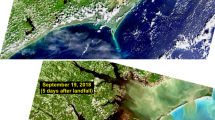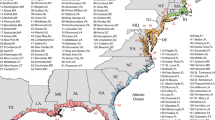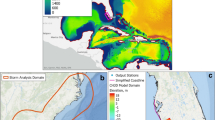Abstract
The future impacts of climate change on landfalling tropical cyclones are unclear. Regardless of this uncertainty, flooding by tropical cyclones will increase as a result of accelerated sea-level rise. Under similar rates of rapid sea-level rise during the early Holocene epoch most low-lying sedimentary coastlines were generally much less resilient to storm impacts. Society must learn to live with a rapidly evolving shoreline that is increasingly prone to flooding from tropical cyclones. These impacts can be mitigated partly with adaptive strategies, which include careful stewardship of sediments and reductions in human-induced land subsidence.
This is a preview of subscription content, access via your institution
Access options
Subscribe to this journal
Receive 51 print issues and online access
$199.00 per year
only $3.90 per issue
Buy this article
- Purchase on Springer Link
- Instant access to full article PDF
Prices may be subject to local taxes which are calculated during checkout




Similar content being viewed by others
References
Peduzzi, P. et al. Global trends in tropical cyclone risk. Nature Clim. Change 2, 289–294 (2012).
Knutson, T. R. et al. Tropical cyclones and climate change. Nature Geosci. 3, 157–163 (2010). This article provides the most current community consensus on projections of future tropical cyclone activity.
EM-DAT. The OFDA/CRED International Disaster Database. http://www.emdat.be (CRED, 2013).
Pielke, R. A. et al. Normalized hurricane damage in the United States: 1900–2005. Nat. Hazards Rev. 9, 29–42 (2008).
Mendelsohn, R., Emanuel, K., Chonabayashi, S. & Bakkensen, L. The impact of climate change on global tropical cyclone damage. Nature Clim. Change 2, 205–209 (2012).
Frank, W. M. & Young, G. S. The interannual variability of tropical cyclones. Mon. Weath. Rev. 135, 3587–3598 (2007).
Weinkle, J., Maue, R. & Pielke, R. Jr. Historical global tropical cyclone landfalls. J. Clim. 25, 4729–4735 (2012).
Gray, W. M. in Meteorology Over the Tropical Oceans (ed. Shaw, D. B.) 155–218 (Royal Meteorological Society, 1979).
Emanuel, K. A. The maximum intensity of hurricanes. J. Atmos. Sci. 45, 1143–1155 (1988). This article presents a theoretical foundation for the direct relationship between SST and the intensity of tropical cyclones.
Camargo, S. J., Emanuel, K. A. & Sobel, A. H. Use of a genesis potential index to diagnose ENSO effects on tropical cyclone genesis. J. Clim. 20, 4819–4834 (2007).
Tippett, M. K., Camargo, S. J. & Sobel, A. H. A Poisson regression index for tropical cyclone genesis and the role of large-scale vorticity in genesis. J. Clim. 24, 2335–2357 (2011).
Gray, W. M. Atlantic seasonal hurricane frequency. Part I: El Niño and 30 mb Quasi-Biennial Oscillation influences. Mon. Weath. Rev. 112, 1649–1668 (1984).
Frank, W. M. & Ritchie, E. A. Effects of vertical wind shear on the intensity and structure of numerically simulated hurricanes. Mon. Weath. Rev. 129, 2249–2269 (2001).
Villarini, G. & Vecchi, G. A. Twenty-first-century projections of North Atlantic tropical storms from CMIP5 models. Nature Clim. Change 2, 604–607 (2012).
Villarini, G. & Vecchi, G. A. Projected increases in North Atlantic tropical cyclone intensity from CMIP5 models. J. Clim. 26, 3231–3240 (2013).
Kim, J.-H., Ho, C.-H., Kim, H.-S., Sui, C.-H. & Park, S. K. Systematic variation of summertime tropical cyclone activity in the western North Pacific in relation to the Madden–Julian oscillation. J. Clim. 21, 1171–1191 (2008).
Barrett, B. S. & Leslie, L. M. Links between tropical cyclone activity and Madden–Julian Oscillation phase in the North Atlantic and northeast Pacific basins. Mon. Weath. Rev. 137, 727–744 (2009).
Stevenson, S. Significant changes to ENSO strength and impacts in the twenty-first century: results from CMIP5. Geophys. Res. Lett. 39, L17703 (2012).
Takahashi, C., Sato, N., Seiki, A., Yoneyama, K. & Shirooka, R. Projected future change of MJO and its extratropical teleconnection in east Asia during the northern winter simulated in IPCC AR4 models. SOLA 7, 201–204 (2011).
Camargo, S. J., Sobel, A. H., Barnston, A. G. & Klotzbach, P. J. in Global Perspectives on Tropical Cyclones: From Science to Mitigation, Vol. 4 (eds Chan, J. C. L. & Kepert, J. D.) (World Scientific Publishing Company, 2010).
Jones, S. C. et al. The extratropical transition of tropical cyclones: forecast challenges, current understanding, and future directions. Weather Forecast. 18, 1052–1092 (2003).
Kossin, J. P. & Camargo, S. J. Hurricane track variability and secular potential intensity trends. Clim. Change 97, 329–337 (2009).
Parris, A. et al. Global Sea Level Rise Scenarios for the US National Climate Assessment. NOAA Tech Memo OAR CPO-1 (NOAA, 2012).
Woodworth, P. & Player, R. The permanent service for mean sea level: an update to the 21st century. J. Coast. Res. 19, 287–295 (2003).
Menéndez, M. & Woodworth, P. L. Changes in extreme high water levels based on a quasi-global tide-gauge data set. J. Geophys. Res. 115, C10011 (2010).
Zhang, K., Douglas, B. C. & Leatherman, S. P. Twentieth-century storm activity along the US east coast. J. Clim. 13, 1748–1761 (2000).
Irish, J. L., Resio, D. T. & Divoky, D. Statistical properties of hurricane surge along a coast. J. Geophys. Res. 116, C10007 (2011).
Resio, D. T. & Westerink, J. J. Modeling the physics of storm surges. Phys. Today 61, 33 (2008).
Nicholls, R. J. & Cazenave, A. Sea-level rise and its impact on coastal zones. Science 328, 1517–1520 (2010). This article outlines future challenges for world regions most vulnerable to future sea-level rise and subsidence.
Han, M., Hou, J. & Wu, L. Potential impacts of sea-level rise on China's coastal environment and cities: a national assessment. J. Coast. Res. 14, 79–95 (1995).
Knutson, T. R. & Tuleya, R. E. Impact of CO2-induced warming on simulated hurricane intensity and precipitation: sensitivity to the choice of climate model and convective parameterization. J. Clim. 17, 3477–3495 (2004).
Knutson, T. R. & Tuleya, R. E. In: Climate Extremes and Society (eds Diaz, H. F. & Murnane, R. J.) 120–144 (2008).
Emanuel, K. Increasing destructiveness of tropical cyclones over the past 30 years. Nature 436, 686–688 (2005).
Nicholls, R. J., Hoozemans, F. M. J. & Marchand, M. Increasing flood risk and wetland losses due to global sea-level rise: regional and global analyses. Glob. Environ. Change 9, S69–S87 (1999).
Hanson, S. et al. A global ranking of port cities with high exposure to climate extremes. Clim. Change 104, 89–111 (2011).
Ali, A. Climate change impacts and adaptation assessment in Bangladesh. Clim. Res. 12, 109–116 (1999).
Church, J. A., Hunter, J. R., McInnes, K. L. & White, N. J. Sea-level rise around the Australian coastline and the changing frequency of extreme sea-level events. Aust. Meteorol. Mag. 55, 253–260 (2006).
Irish, J. L. & Resio, D. T. A method for estimating future hurricane flood probabilities and associated uncertainty. J. Waterw. Port Coast. Ocean Eng. 139, 126–134 (2013).
Lin, N., Emanuel, K., Oppenheimer, M. & Vanmarcke, E. Physically based assessment of hurricane surge threat under climate change. Nature Clim. Change 2, 462–467 (2012). This study provides a rigorous evaluation for the combined influence of SLR and future tropical cyclone climate on storm surge probabilities.
Smith, J. M., Cialone, M. A., Wamsley, T. V. & McAlpin, T. O. Potential impact of sea level rise on coastal surges in southeast Louisiana. Ocean Eng. 37, 37–47 (2010). This is one of a number of important studies that quantify the nonlinear effects on surge by SLR.
Rodolfo, K. S. & Siringan, F. P. Global sea-level rise is recognized, but flooding from anthropogenic land subsidence is ignored around northern Manila Bay, Philippines. Disasters 30, 118–139 (2006).
Nicholls, R. J. Coastal megacities and climate change. GeoJournal 37, 369–379 (1995).
Wang, J., Gao, W., Xu, S. & Yu, L. Evaluation of the combined risk of sea level rise, land subsidence, and storm surges on the coastal areas of Shanghai, China. Clim. Change 115, 537–558 (2012).
Neumann, J. E., Emanuel, K. A., Ravela, S., Ludwig, L. C. & Verly, C. WP 2012/81 Risks of Coastal Storm Surge and the Effect of Sea Level Rise in the Red River Delta, Vietnam (UNU–WIDER, 2012).
Hoffman, R. N. et al. An estimate of increases in storm surge risk to property from sea level rise in the first half of the twenty-first century. Weather Clim. Soc. 2, 271–293 (2010).
Uehara, K., Scourse, J. D., Horsburgh, K. J., Lambeck, K. & Purcell, A. P. Tidal evolution of the northwest European shelf seas from the Last Glacial Maximum to the present. J. Geophys. Res. 111, C09025 (2006).
Hughes, T. P. et al. Climate change, human impacts, and the resilience of coral reefs. Science 301, 929–933 (2003).
Hoegh-Guldberg, O. et al. Coral reefs under rapid climate change and ocean acidification. Science 318, 1737–1742 (2007).
FitzGerald, D. M., Fenster, M. S., Argow, B. A. & Buynevich, I. V. Coastal impacts due to sea-level rise. Annu. Rev. Earth Planet. Sci. 36, 601–647 (2008). This paper reviews a century of research on shoreline change in response to changes in sea level.
Goodbred, S. L. Jr, Wright, E. E. & Hine, A. C. Sea-level change and storm-surge deposition in a late Holocene Florida salt marsh. J. Sediment. Res. 68, 240–252 (1998).
Friedrichs, C. T. & Perry, J. E. Tidal salt marsh morphodynamics: a synthesis. J. Coast. Res. 27, 7–37 (2001).
Stumpf, R. P. The process of sedimentation on the surface of a salt marsh. Estuar. Coast. Shelf Sci. 17, 495–508 (1983).
Cooper, M. J. P., Beevers, M. D. & Oppenheimer, M. The potential impacts of sea level rise on the coastal region of New Jersey, USA. Clim. Change 90, 475–492 (2008).
Larcombe, P. & Carter, R. Cyclone pumping, sediment partitioning and the development of the Great Barrier Reef shelf system: a review. Quat. Sci. Rev. 23, 107–135 (2004).
Nott, J. Tropical cyclones and the evolution of the sedimentary coast of northern Australia. J. Coast. Res. 22, 49–62 (2006).
Cooper, J. A. G. & Pilkey, O. H. Sea-level rise and shoreline retreat: time to abandon the Bruun Rule. Global Planet. Change 43, 157–171 (2004).
Morton, R. A., Paine, J. G. & Gibeaut, J. C. Stages and durations of post-storm beach recovery, southeastern Texas coast, USA. J. Coast. Res. 10, 884–908 (1994).
Ranasinghe, R., Duong, T. M., Uhlenbrook, S., Roelvink, D. & Stive, M. Climate-change impact assessment for inlet-interrupted coastlines. Nature Clim. Change 3, 83–87 (2012).
Morton, R. A. & Sallenger, A. H. Jr. Morphological impacts of extreme storms on sandy beaches and barriers. J. Coast. Res. 19, 560–573 (2003).
Wamsley, T. V., Cialone, M. A., Smith, J. M., Ebersole, B. A. & Grzegorzewski, A. S. Influence of landscape restoration and degradation on storm surge and waves in southern Louisiana. Nat. Hazards 51, 207–224 (2009).
Fagherazzi, S., Carniello, L., D'Alpaos, L. & Defina, A. Critical bifurcation of shallow microtidal landforms in tidal flats and salt marshes. Proc. Natl Acad. Sci. USA 103, 8337–8341 (2006).
Mariotti, G. & Fagherazzi, S. Critical width of tidal flats triggers marsh collapse in the absence of sea-level rise. Proc. Natl Acad. Sci. USA 110, 5353–5356 (2013).
Zhang, K., Douglas, B. & Leatherman, S. Do storms cause long-term beach erosion along the US East Barrier Coast? J. Geol. 110, 493–502 (2002). This article presents evidence for the dominance of sea-level rise and variations of sediment supply in driving long-term rates of shore-line retreat.
Harmelin-Vivien, M. L. The effects of storms and cyclones on coral reefs: a review. J. Coast. Res. 12, 211–231 (1994).
Wang, P. et al. Morphological and sedimentological impacts of Hurricane Ivan and immediate poststorm beach recovery along the northwestern Florida barrier-island coasts. J. Coast. Res. 22, 1382–1402 (2006).
Done, T. J. Coral community adaptability to environmental change at the scales of regions, reefs and reef zones. Am. Zool. 39, 66–79 (1999).
Donoghue, J. F. Sea level history of the northern Gulf of Mexico coast and sea level rise scenarios for the near future. Clim. Change 107, 17–33 (2011).
Emery, K., Wigley, R. & Rubin, M. A submerged peat deposit off the Atlantic coast of the United States. Limnol. Oceanogr. 10, R97–R102 (1965).
Field, M. E., Meisburger, E. P., Stanley, E. A. & Williams, S. J. Upper Quaternary peat deposits on the Atlantic inner shelf of the United States. Geol. Soc. Am. Bull. 90, 618–628 (1979).
Pluet, J. & Pirazzoli, P. World Atlas of Holocene Sea-Level Changes Vol. 58 (Elsevier, 1991).
Stanley, D. J. & Warne, A. G. Worldwide initiation of Holocene marine deltas by deceleration of sea-level rise. Science 265, 228–231 (1994).
Kraft, J. C. Sedimentary facies patterns and geologic history of a Holocene marine transgression. Geol. Soc. Am. Bull. 82, 2131–2158 (1971). This article provides evidence for the landward transgression and reworking of the continental shelf by rapid rates of sea-level rise during the early Holocene.
Anderson, J., Milliken, K., Wallace, D., Rodriguez, A. & Simms, A. Coastal impact underestimated from rapid sea-level rise. Eos 91, 205–206 (2010).
Rhodes, E. Depositional model for a chenier plain, Gulf of Carpentaria, Australia. Sedimentology 29, 201–221 (1982).
Otvos, E. G. Coastal barriers, Gulf of Mexico: Holocene evolution and chronology. J. Coast. Res. 42, 141–163 (2005).
Redfield, A. C. Development of a New England salt marsh. Ecol. Monogr. 42, 201–237 (1972).
Newman, W. S. & Rusnak, G. A. Holocene submergence of the eastern shore of Virginia. Science 148, 1464–1466 (1965).
Ellison, J. C. & Stoddart, D. R. Mangrove ecosystem collapse during predicted sea-level rise: Holocene analogues and implications. J. Coast. Res. 7, 151–165 (1991).
Parkinson, R. W., DeLaune, R. D. & White, J. R. Holocene sea-level rise and the fate of mangrove forests within the wider Caribbean region. J. Coast. Res. 10, 1077–1086 (1994).
Mann, M., Woodruff, J., Donnelly, J. & Zhang, Z. Atlantic hurricanes and climate over the past 1,500 years. Nature 460, 880–883 (2009).
Woodruff, J. D., Donnelly, J. P., Emanuel, K. & Lane, P. Assessing sedimentary records of paleohurricane activity using modeled hurricane climatology. Geochem. Geophys. Geosyst. 9, Q09V10 (2008).
Nott, J. & Forsyth, A. Punctuated global tropical cyclone activity over the past 5,000 years. Geophys. Res. Lett. 39, L14703 (2012).
Lewis, S. E., Sloss, C. R., Murray-Wallace, C. V., Woodroffe, C. D. & Smithers, S. G. Post-glacial sea-level changes around the Australian margin: a review. Quat. Sci. Rev. 74, 115–138 (2013).
Dasgupta, S., Laplante, B., Murray, S. & Wheeler, D. Exposure of developing countries to sea-level rise and storm surges. Clim. Change 106, 567–579 (2011).
Webster, P. J. Meteorology: Improve weather forecasts for the developing world. Nature 493, 17–19 (2013).
Brecht, H., Dasgupta, S., Laplante, B., Murray, S. & Wheeler, D. Sea-level rise and storm surges: High stakes for a small number of developing countries. J. Environ. Dev. 21, 120–138 (2012).
Jarvinen, B. R., Neuman, C. & Davis, M. NOAA Tech. Memo. NWS NHC-22, A Tropical Cyclone Data Tape for the North Atlantic basin (NOAA, 1988).
Chu, J.-H., Sampson, C. R., Levine, A. S. & Fukada, E. The Joint Typhoon Warning Center Tropical Cyclone Best-Tracks, 1945–2000 (Naval Research Laboratory, 2002).
McTaggart-Cowan, R. et al. Analysis of hurricane Catarina (2004). Mon. Weath. Rev. 134, 3029–3053 (2006).
Permanent Service for Mean Sea Level. Obtaining Tide Gauge Data. http://www.psmsl.org/data/obtaining/ (PSMSL, 2013).
United Nations. World Urbanization Prospects, The 2011 Revision. http://esa.un.org/unup/ (United Nations, 2012).
Karim, M. F. & Mimura, N. Impacts of climate change and sea-level rise on cyclonic storm surge floods in Bangladesh. Glob. Environ. Change 18, 490–500 (2008).
Huang, Z., Zong, Y. & Zhang, W. Coastal inundation due to sea level rise in the Pearl River Delta, China. Nat. Hazards 33, 247–264 (2004).
NOAA. Sea Level Trends. http://tidesandcurrents.noaa.gov/sltrends/ (NOAA, 2013).
Amante, C. & Eakins, B. ETOPO1 1 Arc-Minute Global Relief Model: Procedures, Data Sources and Analysis (DOC/NOAA/NESDIS/NGDC, 2008).
Fleming, K. et al. Refining the eustatic sea-level curve since the Last Glacial Maximum using far-and intermediate-field sites. Earth Planet. Sci. Lett. 163, 327–342 (1998).
Milne, G. A., Long, A. J. & Bassett, S. E. Modelling Holocene relative sea-level observations from the Caribbean and South America. Quat. Sci. Rev. 24, 1183–1202 (2005).
Peltier, W. R. On eustatic sea level history: last glacial maximum to Holocene. Quat. Sci. Rev. 21, 377–396 (2002).
Pugh, D. Changing Sea Levels: Effects of Tides, Weather and Climate (Cambridge Univ. Press, 2004).
Scileppi, E. & Donnelly, J. P. Sedimentary evidence of hurricane strikes in western Long Island, New York. Geochem. Geophys. Geosyst. 8, Q06011 (2007).
Acknowledgements
We wish to thank our colleagues for the many comments and suggestions that improved this manuscript, as well as thoughtful discussions at the 2013 Joint AGU/GSA Conference on 'Coastal Processes and Environments Under Sea-Level Rise and Changing Climate: Science to Inform Management'. J.D.W. is funded through the US National Science Foundation (NSF, grant number EAR-1158780 and EAR-1148244), the Risk Prediction Initiative at the Bermuda Institute of Ocean Sciences (grant number RPI11-1-001/11-5110), and the Hudson River Foundation. S.J.C. acknowledges funding from the National Oceanic and Atmospheric Administration (NOAA, grant number NA11OAR4310093 and NA10OAR4310124) and NSF (grant number AGS-1143959 and AGS-1064081). J.L.I. received funding for this work through NOAA's National Sea Grant College Program (grant number 24036078) and the South Atlantic Landscape Conservation Cooperative (grant number 24036078). The views expressed herein do not necessarily reflect the views of any of these organizations.
Author information
Authors and Affiliations
Corresponding author
Ethics declarations
Competing interests
The authors declare no competing financial interests.
Additional information
Reprints and permissions information is available at www.nature.com/reprint.
Rights and permissions
About this article
Cite this article
Woodruff, J., Irish, J. & Camargo, S. Coastal flooding by tropical cyclones and sea-level rise. Nature 504, 44–52 (2013). https://doi.org/10.1038/nature12855
Received:
Accepted:
Published:
Issue Date:
DOI: https://doi.org/10.1038/nature12855
This article is cited by
-
Global coastal wave storminess
Scientific Reports (2024)
-
Disappearing cities on US coasts
Nature (2024)
-
Climate change impacts assessment on Bangladesh Mangrove Forest using high-resolution datasets and Google Earth Engine
Journal of Coastal Conservation (2024)
-
An observation study of the combined river discharge and sea level impact on the duration of saltwater intrusion in Pearl River estuary–Modaomen waterway
Natural Hazards (2024)
-
Impact assessment of environmental disturbances triggering aquaculture land suitability mapping using AHP and MCDA techniques
Aquaculture International (2024)
Comments
By submitting a comment you agree to abide by our Terms and Community Guidelines. If you find something abusive or that does not comply with our terms or guidelines please flag it as inappropriate.



